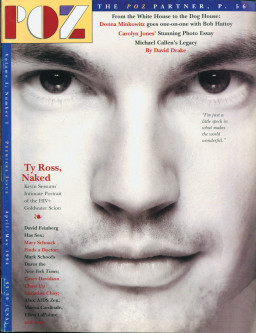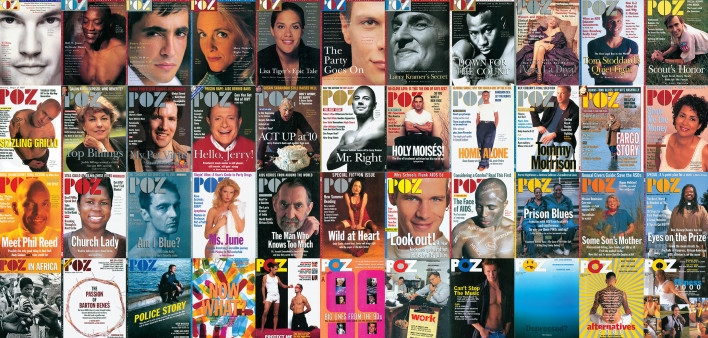POZ recently announced its 25th anniversary. It first published in April 1994. That date is a 25-year anniversary for me too. Not for when I was diagnosed; that was September 1993. Not when I became HIV-positive, I’m guessing about five years before that. No, it’s been 25 years since I first took baby steps as a budding activist, my first real exposure to the entity that is the HIV community.
My activism is winding down now. Like the Garth Brooks song “The Dance” quoted in that first issue of POZ: “And now I’m glad I didn’t know the way it all would end/ the way it all would go/ our lives are better left to chance/ I could have missed the pain, but I’d of had to miss the dance.”

The first issue of POZ, April 1994
In truth though it’s been a good 25 years, an unexpected run that in some ways mirrors that of POZ. Like that remarkable piece of story-telling about Tyler Ross that graced the first issue its early days captured an uncertain future. Early editions of POZ featured ads for companies wanting to buy your life insurance policy, because you weren’t going to need it, once dead. Then-publisher Sean Strub regularly shared his lab results, and later, reflections on the Kaposi’s Sarcoma taking over his face and body. It both shocked and excited me that I was symptom-free. It was though a time when POZ and rival publications like Diseased Pariah News, however upbeat, were redolent with a subtext of death. “News, giggles all the way to the graveyard” said POZ of the beloved DPN in a 1997 article.
POZ started its life as a good-looking and glossy mag. It subsequently added an online version, but it was the glossy magazine that caught my eye in the spring of 1994, a novice volunteer seated at the reception desk of The AIDS Committee of Toronto (ACT), Canada’s largest AIDS Service Organization. While fielding phone calls and welcoming clients, I devoured every word of POZ in those days. Later I subscribed to the print copy; it was free to those living with HIV and arrived at my home in a plain brown envelope.
POZ was able to feature ever more optimistic content as time wore on. In 1995, for example POZ reported on the first effective antiretroviral treatment, Invirase (or its generic name saquinavir). I was on the clinical trial of that drug so I had a head start on the long road to viral suppression, but not without bumps in the road. The drug proved to be a bit of a dud, delivered in a suboptimal dose that caused me resistance problems for years thereafter. I first heard about the problem with saquinavir in a September 1997 POZ article here.
Ten years go by fast. In 2008, the import of a keenly prescient POZ article “Is Treating AIDS the Way to Stop the Spread of the Disease?” didn’t register immediately with me. It featured research by Dr. Julio Montaner, a brilliantly outspoken Canadian researcher who became a key figure in my later career, a person I both got to know and admire. If that article didn’t immediately register, though, this 2008 one did, titled “Controversial Swiss Declaration.” The Swiss Statement, quickly dismissed by every pearl-clutching AIDS agency in Canada fearing a nation of bare-backers having sex in the streets, became a catalyst for my belief that treatment had much more to offer than improved health outcomes.
Fast forward a few years to another milestone. A December 2011 POZ article featured the still-much-derided Montaner cementing his role as a Treatment as Prevention (TasP) pioneer. The article narrates that “current antiretroviral treatments can make the risk of transmitting HIV through sex negligible, even in the absence of condoms. Montaner suggests that an HIV-positive person who has an undetectable viral load or who is practicing safe sex, or both, isn’t actually a risk to anybody?” “Rest assured Montaner is wrong,” Canadian bureaucrats told us. I ignored them. I became an advocate for TasP. I had few allies in my part of the world.

The March 2019 issue
When TasP grew up in the form of U=U, POZ featured heavily in my growth as a U=U champion. I, like POZ, have long felt at home on social media. As editor and later publisher of PositiveLite, Canada’s leading online HIV publication, I had interviewed scores of community leaders. In the summer of 2016 a handsome new interview prospect came to my attention. His name was Bruce Richman. His July 2016 article in POZ “Loud and Clear: Undetectable = Uninfectious” played right into what I knew to be true, so I interviewed Richman for PositiveLite. Sold on his campaign, I quickly signed on PositiveLite as a U=U community partner, the first Canadian agency to do so. Subsequently I brought Bruce to Canada on the first of several speaking tours. We became friends. I watched with pride as the campaign became a juggernaut, a game-changer and for me, an obsession. I marched with it in Paris and Amsterdam. I wrote about it often. So did POZ. POZ awarded it campaign of the year in late 2017.
Full circle and I’m writing for POZ, documenting a journey which begins with the early days of my life with HIV and the influence of the movie Philadelphia and 25 years later, my thoughts on HIV stigma and how U=U can make a difference. Those subjects book-end a 25-year journey whose strands intertwine with the story of POZ magazine in ways that continue to amaze me. Hats off to POZ, I say. It’s been a blast being mixed up with with you every step of the way.

The April 2019 fold-out cover of POZ
To read the 25th anniversary issue of POZ, click here.








Comments
Comments